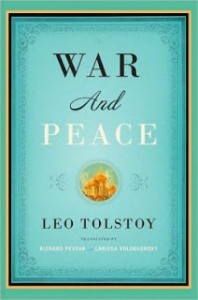This from the site Campaign for the American Reader: What is George Bishop Reading?
Instead of describing what I’m reading now, I thought it might be more interesting to look at what I was reading while I was writing my latest novel, The Night of the Comet.
During the thick of working on Comet, I read Leo Tolstoy’s War and Peace for the first time. It might not be all that evident, but Tolstoy’s novel had a profound impact on the eventual tone and even the shape of my book. Going into Comet, I remember wanting to write something smart, edgy, modern, ironic—the kind of literary fiction that seems to attract attention and praise these days. But Tolstoy’s humanism, his calm, patient, sympathetic voice, reformed me, and I began to aspire to write something that he might’ve approved of. It’s a tall order, I know. But as writers, we only have so much time and so many books in us, and so why aim for anything less than the best? I find this attitude reflected more and more both in my reading and in what I try to accomplish as a writer. Entertaining is good, shocking is fun, innovative is interesting, but profound and meaningful and relevant: that’s much better, isn’t it?
That’s not to say I’ve achieved any of that with The Night of the Comet. But I hope I was able to capture at least a hint of Tolstoy’s breadth, compassion, and honesty in my little book.
About the shape of my novel: I was having a hell of a time trying to figure out how to divide up the chapters, because the story jumped around so much in time and focus. Then I saw how brief the chapters were in War and Peace, and I reasoned that if it was good enough for Tolstoy, it was good enough for me. That’s how I eventually decided to section my novel into fifty or so relatively short chapters.
